Milwaukee Area Domestic Animal Control (MADACC) killed 5357 animals in 2012. (This does not include those that died in their kennel, were dead on arrival, or were owner-requested euthanasia).
Six birds, 3514 cats, 1783 dogs, and 54 other animals died at MADACC. The charts below show comparisons from last year to this year and also the breakdown of the December statistics. As you can see, transfers and reclaims where sharply down in December.
Some improvement in overall numbers has been shown over last year but other cities in America are doing much better while Milwaukee is lagging behind. Cities such as Reno, Austin, San Antonio, Jacksonville, Salt Lake City and Kansas City, Missouri are improving their animal control programs and saving lives.
The key to solving the problem is knowing that there is a problem. If you did not know that MADACC had such a high death rate for animals in Milwaukee County please share this blog post with your friends and neighbors. If you are a resident of Milwaukee County please contact your local alderman to express your displeasure. Milwaukee County animal control is funded by your tax dollars.
Do you ever wonder which shelters and rescue groups transfer the most animals out of MADACC and make them available for adoption at their own facilities? Here are the year to date through December 2012 transfer numbers. You can also compare to the transfer numbers from 2011.
Of course, there are a lot of things to be taken into consideration. One of the top-pulling rescues, Remember Me Ranch, has been "banned" from pulling dogs. Current MADACC management also makes it incredibly difficult for rescues and shelters to pull dogs. There is a serious lack of communication. They also make it difficult for BRATS, the all volunteer transport service, to facilitate the transfer. Plus, many of the dogs leaving MADACC are sick because of poor sanitation and veterinary practices. This makes shelters and rescues reluctant to "pull" because it can be very expensive to rehabilitate sick or injured dogs. There is also the risk of disease transmission to the rest of their shelter's animals.
Transparency is the key to making changes for our companion animals. We must know what the problem is if we are going to try to solve it.
We would like to take this opportunity to wish you all a wonderful 2013. Great strides are being made across our nation for companion animals. Please follow our blog, our website and especially our Facebook page as we share these stories and work towards even more improvements for Wisconsin's companion animals. It will take an army of compassion, including YOU, to bring about a time when every companion animal in America has the opportunity for a loving home.
We would also like to take this opportunity to review our six focuses. They are in no particular order. Current affairs will sometimes deem us to spend more time on one issue than another, but they are all important. Please join us in our mission.
-
Breed Specific (Discriminatory) Legislation (BSL or BDL): Wisconsin Voters for Companion Animals is opposed to laws that ban or discriminate against specific dog breeds or breed mixes without regard to the temperament and behavior of individual dogs. This includes fencing or kenneling requirements and collar or muzzle requirements. Several Wisconsin municipalities currently have some form of BDL.
-
Community Cats: At Wisconsin Voters for Companion Animals we believe that all cats deserve to live. This includes feral (community) cats, barn cats, working cats, outdoor cats, and cats with treatable or manageable diseases such as FIV, FELV, and ringworm. We believe that the most humane, effective and financially sustainable strategy for controlling free-roaming cat populations is trap-neuter-return (TNR), whereby free-roaming cats are trapped, sterfilized, vaccinated, and returned to their colony of origin. We will advocate for legislation that protects feral cat caregivers and their cat, and legalizes trap neuter return in Wisconsin.
-
Pet Stores and Commercial Breeders: It is estimated that over 90 percent of pets sold in pet stores and through online sales come from commercial, mass breeding operations known as mills, including puppy, kitten, bird and rabbit mills. These commercial breeding operations are inherently exploitive not only of the animals trapped in inhumane breeding conditions, but also of the public that purchase over-priced pets, many of whom have diseases, genetic defects and behavior problems due to poor breeding practices, inadequate nutrition and lack of socialization and veterinary care. Wisconsin Voters for Companion Animals does acknowledge that there are responsible and caring breeders. We invite them to join us in our mission to put an end to cruel, inhumane breeding practices in our state.
-
Animal Cruelty: At Wisconsin Voters for Companion Animals we believe that 95% of the population are good people who love animals and will choose kindness over cruelty. This is evidenced by the continued growth in the pet industry and the increased interest in animal welfare issues around the nation. We also believe that when someone is convicted of animal cruelty they should be punished to the fullest extent of the law. Stricter animal cruelty laws will deter and punish offenders, and we support efforts to strengthen our existing laws.
-
Reforming Animal Control: The number one cause of death of companion animals in the United States is shelter killing. A No Kill Nation is within our reach. Currently there are at least 80 open admission No Kill animal shelters in America. No Kill animal sheltering saves the lives of companion animals and, when done effectively, saves taxpayers' money. Wisconsin Voters for Companion Animals strongly supports the model of No Kill Animal Sheltering and will support legislation that mandates it for our state's animal shelters.
- Justice Alliance Milwaukee: Justice Alliance Milwaukee's initiatives are to gain freedom for unforfeited seized dogs awaiting court trials in Milwaukee (MADACC), ensuring they are individually evaluated and rehabilitated if possible; to ensure the disposition of subsequent seized dogs in Milwaukee match the American Bar Association's guidelines for seized dogs; and to update State Statutes to secure the forfeiture, release, fair evaluation, and rehabilitation of seized dogs in as little time as possible. Wisconsin Voters for Companion Animlas will support legislation that expedites the process for court case dogs so they can be fairly evaluated and have a chance to live out their lives in a loving home.
Milwaukee Area Domestic Animal Control (MADACC has killed 5063 animals so far this year through November 30, 2012. (This does not include those that died in their kennel, were dead on arrival, or were owner-requested euthanasia).
Six birds, 3353 cats, 1652 dogs, and 52 other animals died at MADACC. The charts below show comparisons from last year to this year and also the breakdown of the November statistics. As you can see, in November alone, MADACC killed 405 animals. Summer months are generally the busiest months for animal control, intake numbers typically decrease in the fall and winter.
Especially troubling is that seven animals died in their kennel in November 2012. A 600% increase from November 2011.
Some improvement in overall numbers has been shown over last November but other cities in America are doing much better while Milwaukee is lagging behind. Cities such as Reno, Austin, San Antonio, Jacksonville, Salt Lake City and Kansas City, Missouri are improving their animal control programs and saving lives.
The key to solving the problem is knowing that there is a problem. If you did not know that MADACC had such a high death rate for animals in Milwaukee County please share this blog post with your friends and neighbors. If you are a resident of Milwaukee County please contact your local alderman to express your displeasure. Milwaukee County animal control is funded by your tax dollars.
Do you ever wonder which shelters and rescue groups transfer the most animals out of MADACC and make them available for adoption at their own facilities? Here are the year to date through November 2012 transfer numbers. You can also compare to the transfer numbers from 2011.
Of course, there are a lot of things to be taken into consideration. One of the top-pulling rescues, Remember Me Ranch, has been "banned" from pulling dogs. Current MADACC management also makes it incredibly difficult for rescues and shelters to pull dogs. There is a serious lack of communication. They also make it difficult for BRATS, the all volunteer transport service, to facilitate the transfer. Plus, many of the dogs leaving MADACC are sick because of poor sanitation and veterinary practices. This makes shelters and rescues reluctant to "pull" because it can be very expensive to rehabilitate sick or injured dogs. There is also the risk of disease transmission to the rest of their shelter's animals.
Transparency is the key to making changes for our companion animals. We must know what the problem is if we are going to try to solve it.
"The State of Wisconsin recognized the importance of having a public informed about governmental affairs. The state's open meetings law declares that:
In recognition of the fact that a representative government of the American type is dependent upon an informed electorate, it is declared to be the policy of this state that the public is entitled to the fullest and most complete regarding the affairs of government as is compatible with the conduct of governmental business."
The above two paragraphs are taken directly from the Compliance Guide for the Wisconsin Open Meetings Law that was written in August 2010. How does it affect animal advocacy? What does it mean for you, a concerned citizen that is speaking out for animals in your Wisconsin community?
Here are a few highlights and then please follow the link above for the full guide.
- Every meeting that is held by a governmental body must abide by the Open Meeting Law. There are clear definitions of a "governmental body" in the guide. For instance, Milwaukee Area Domestic Animal Control Commission is clearly a governmental body.
- Telephone conference calls are included under the Open Meetings Law. To comply, the governmental body conducting a meeting by telephone conference call must provide the public with an effective means to monitor the conference.
- Giving advance public notice of each meeting is a basic requirement of the Open Meetings Law. This notice must be published in the designated newspaper and include the time, date, and subject matter of the meeting.
- The public should be given notice 24 hours in advance of the meeting.
- All business must be conducted in an open session, unless an exemption to the open session requirement applies (personnel, employment and compensation matters are exempt)
- The location of the meeting should be reasonably accessible to the public and in a room that is large enough to accommodate all citizens who wish to attend the meetings.
- The Attorney General and the district attorneys have authority to enforce the Open Meetings Law. A formal complaint must be filed.
- Any member of a governmental body who "knowingly" attends a meeting held in violation of the Open Meetings Law, or otherwise violates the law is subject to financial penalties ranging from $25 to $300 for each violation.
This is just a brief overview of the Compliance Guide. Please refer to it for more detailed information.
Milwaukee Area Domestic Animal Control (MADACC) has killed 4655 animals this year through October 31, 2012. (This does not include those that died in their kennel, were dead on arrival, or were owner-requested euthanasia).
Six birds, 3078 cats, 1519 dogs, and 52 other animals died at MADACC. The charts below show comparisons from last year to this year and also the breakdown of the October statistics. As you can see, in October alone, MADACC killed 517 animals. Summer months are generally the busiest months for animal control, intake numbers usually decrease in the fall.
Some improvement has been shown over last October but other cities in America are doing much better while Milwaukee is lagging behind. Cities such as Reno, Austin, San Antonio, Jacksonville, Salt Lake City and Kansas City, Missouri are improving their animal control programs and saving lives.
The key to solving the problem is knowing that there is a problem. If you did not know that MADACC had such a high death rate for animals in Milwaukee County please share this blog post with your friends and neighbors. If you are a resident of Milwaukee County please contact your local alderman to express your displeasure. Milwaukee County animal control is funded by your tax dollars.
n 2011, MADACC took in 12,719 animals. Fifty two percent of those did not make it out alive. Click this link to view the 2011 statistics on Madacc's website.
Do you ever wonder which shelters and rescue groups help the most by transferring animals out of MADACC and making them available for adoption? Here are the year to date through October 2012 transfer numbers. You can also compare to the transfer numbers from 2011. As you can see, transfers are down compared to the same period last year, but up overall. Most improved is the number of cats transferred out.
We will be trying to post statistics regularly here on our website and helping you make sense of what they mean. Transparency is key to making change for our companion animals. We must know what the problem is if we are going to try to solve it.
|
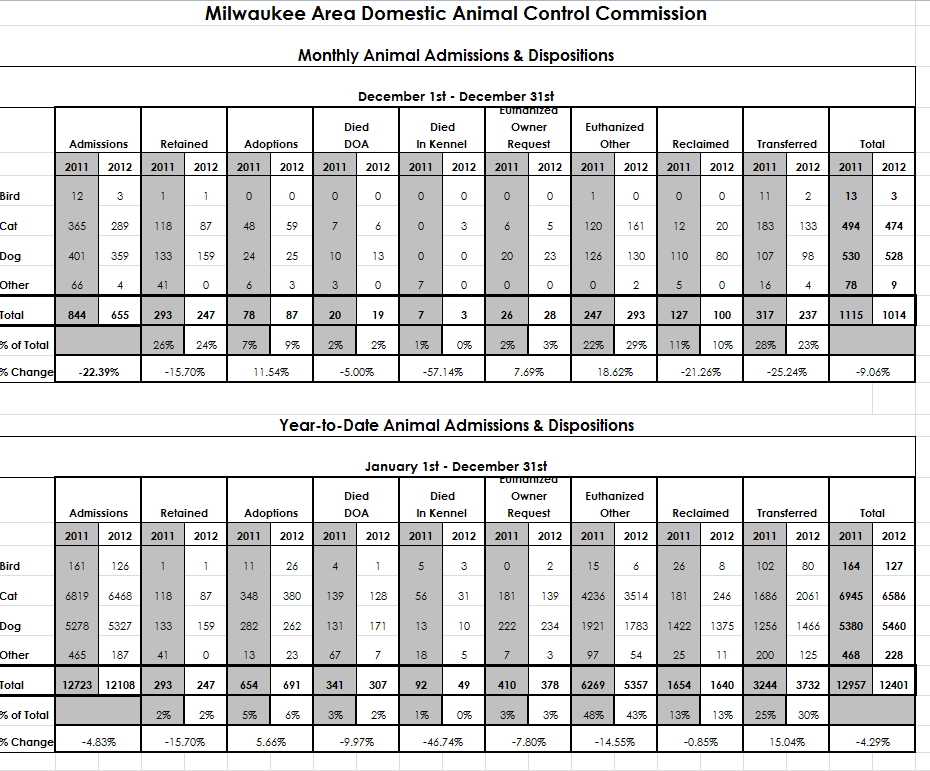
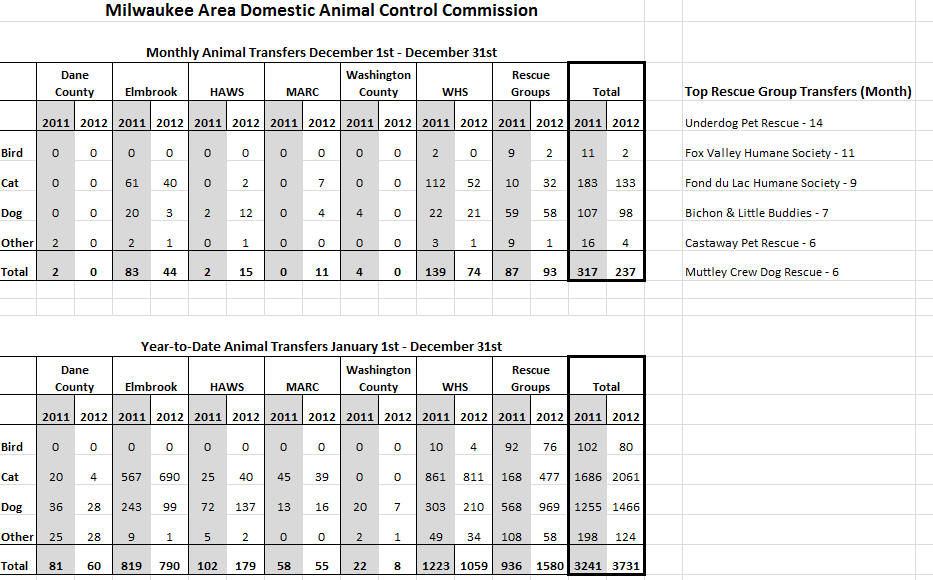
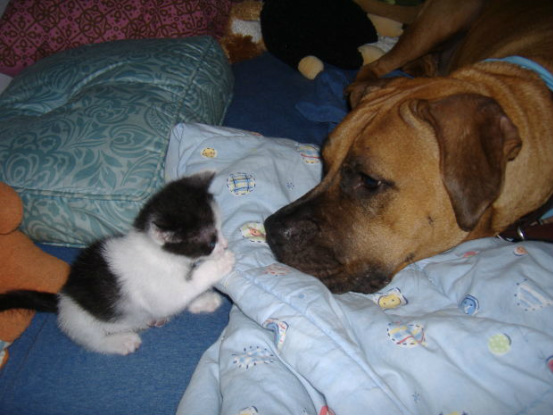

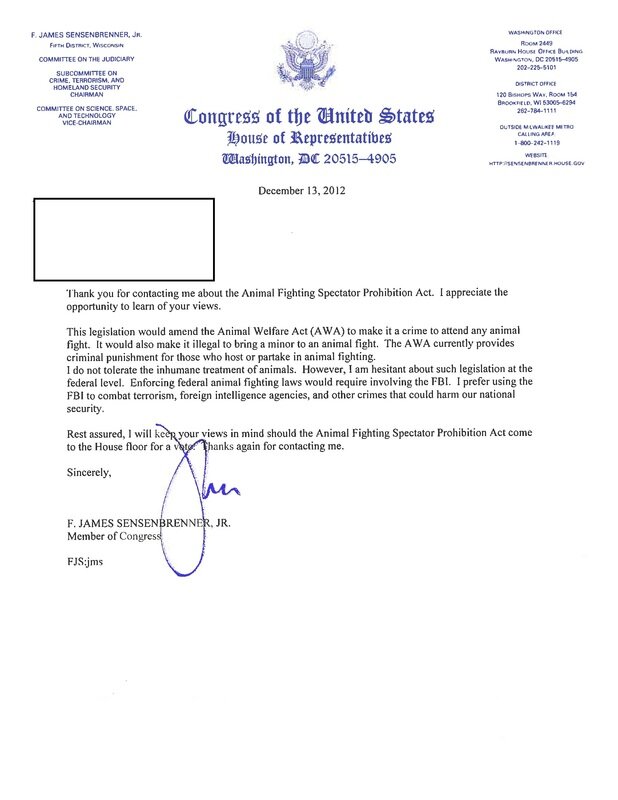

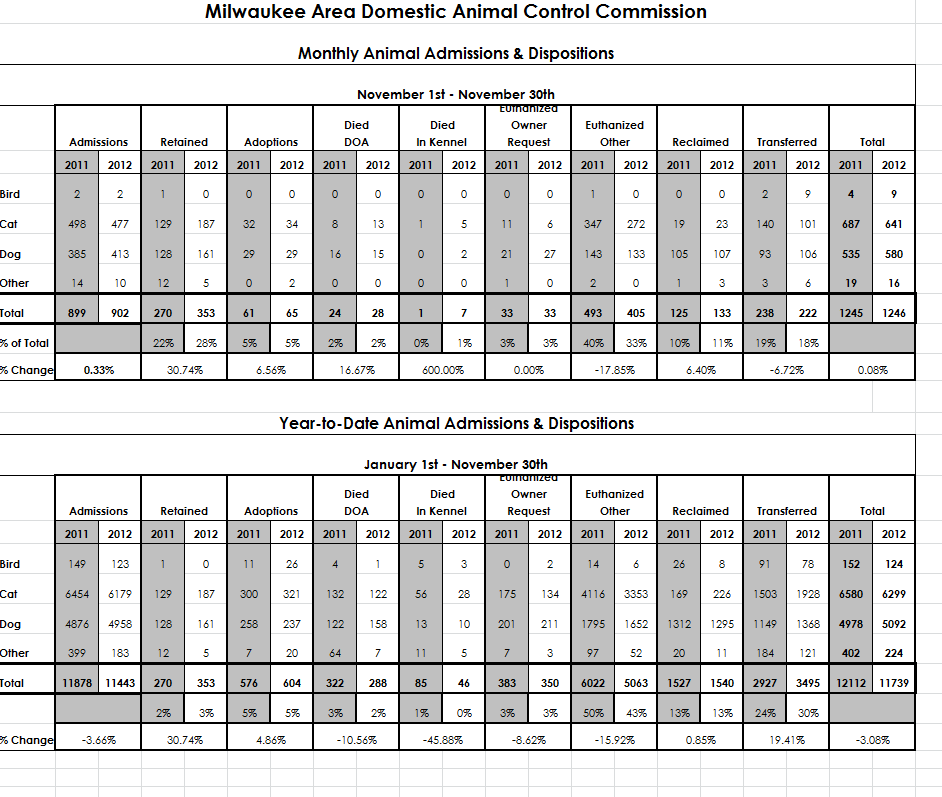
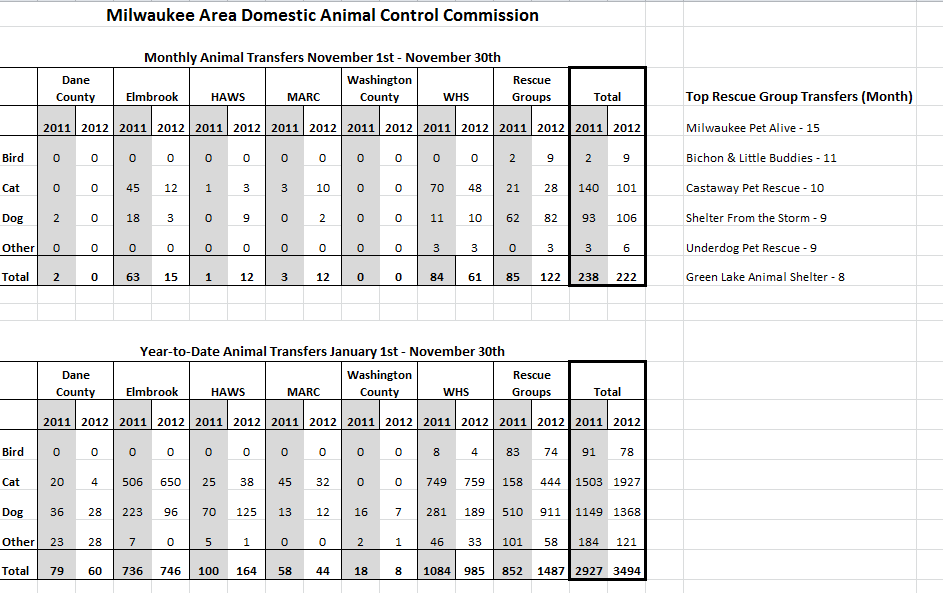
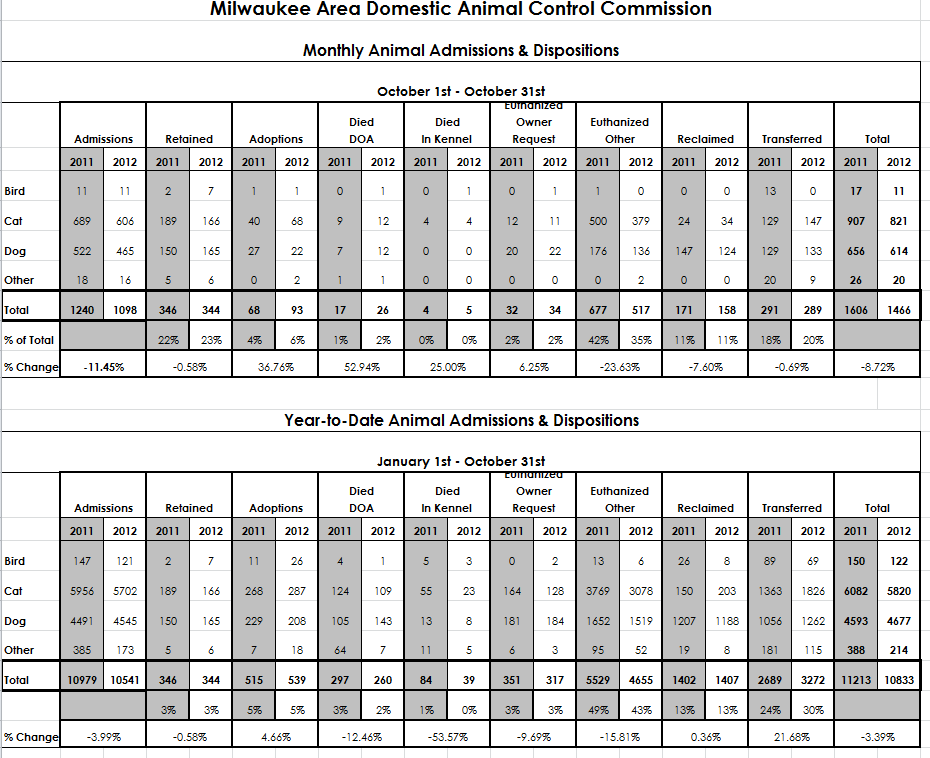
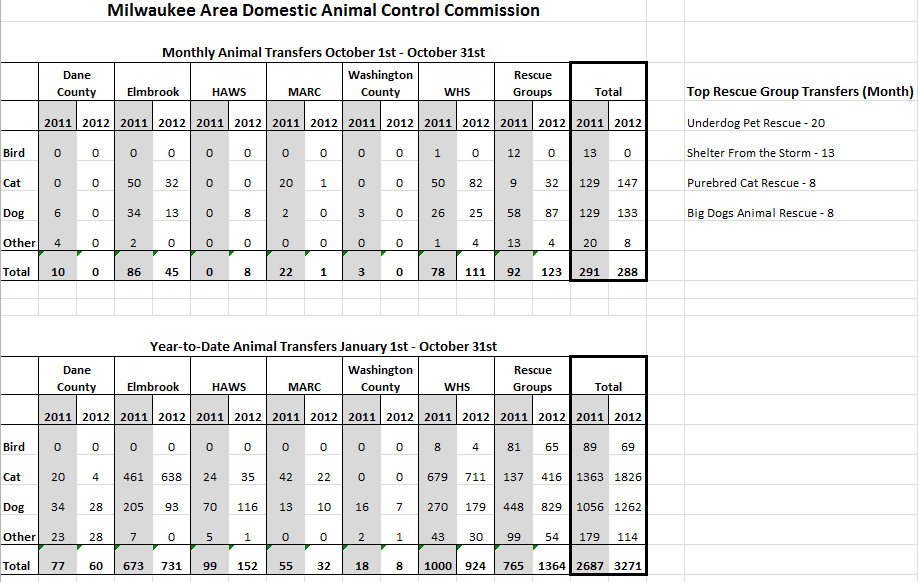
 RSS Feed
RSS Feed